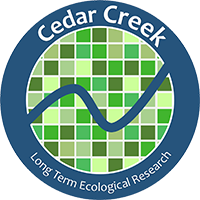The objective of this experiment is to determine the distances over which Schizachyrium scoparium can reduce available soil N. This experiment is being conducted in field B, outside the fenced area of the microplots. Each experimental unit consists of a circular plot of 3 meters diameter, at the center of which there is a Schizachyrium scoparium plant. Two treatments are being tested:
1 (=A). All the vegetation around the central S. scoparium was killed with roundup at a rate of 2.04 g/m2 (1g of Isopropylamine salt of N (phosphonomethyl ) Glycine ). Spraying was repeated at the same rate as needed (Yearly folder). A plastic barrier, 80 cm high, was placed around each Schizachyrium scoparium plant to protect it from any drift that might occur. The area sprayed is the circle with 2 m radius around the central plant.
2 (=B). The vegetation around S. scoparium is left intact. Each treatment is replicated 5 times. The two treatments were randomly assigned to the 10 plots of the experiment.
The plot layout is:
Plot # Treatment
1 2
2 1
3 2
4 2
5 1
6 1
7 1
8 2
9 2
10 1
Soil samples were taken several times and the amount of ammonium and nitrate were determined at the lab. Soil samples were also taken once for mineralization rate, microbial biomass and total carbon determination. When plants reached maturity, they were harvested and dried for dry matter determination, then ground for tissue nitrogen determination. For an additional list of treatments see the treatment layouts in file trmte38.
